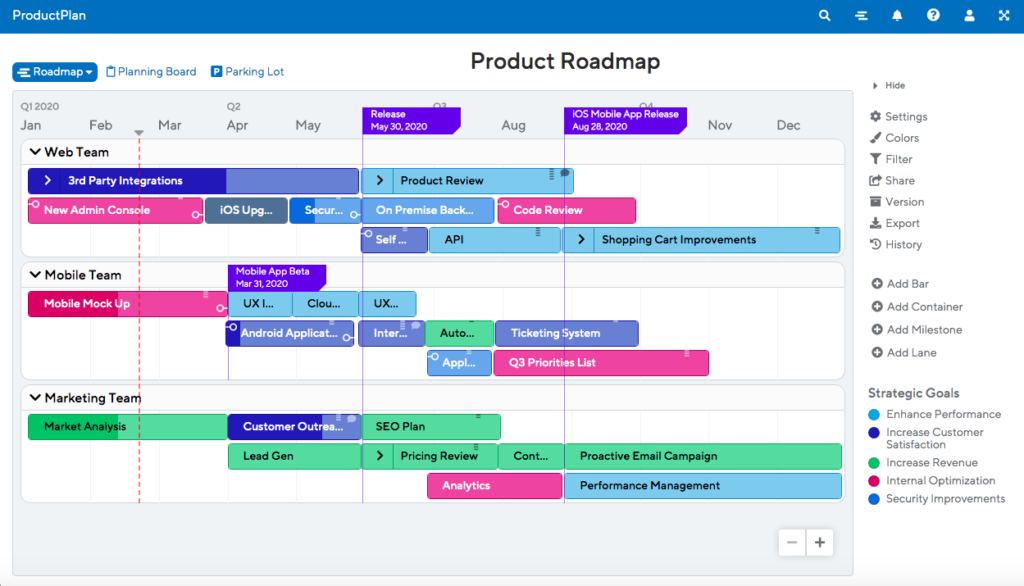What do we mean— make your roadmap a single source of truth?
To develop a successful product, you’ll need the help of many teams throughout your company. You’ll need coordination among those teams. You’ll need a well-thought-out strategy. And above all, you’ll need everyone working toward an agreed-upon set of goals and plans. Those shared goals and plans represent what we call a single source of truth.
In business, a single source of truth refers to one set of information, centrally located and accessible, that everyone agrees is the most accurate and up to date. This process ensures that the team uses consistent information to make decisions that affect the business. For example, a marketing team might base its planned budget for pay-per-click ads on the performance of a specific digital-ad metric. Everyone on the team agrees to view that same metric, using the same source (say, Google Analytics), to base their decisions.
For a product team, a single source of truth should include the most current priorities, strategic objectives, and high-level plans. We believe the best way to capture and communicate these details is the product roadmap. To explain why, and to show you how to turn your own roadmap into a single source of truth, this post summarizes insights and tips from ProductPlan’s Director of Product Management, Annie Dunham.
Why should your single source of truth be your roadmap?
When we talk about a single source of truth, we’re referring to your team’s current high-level thinking and planning for your product. It doesn’t need to include the entire truth, or every truth you can think of.
We recommend using the product roadmap as your single source of truth — and not your product backlog, sprint backlog, or other task-level documents. Those documents contain truths. But they don’t represent your team’s strategic goals and priorities.
The point of having a single source of truth for your product is that anyone on your team can check in with it anytime to make sure the work they’re doing and the decisions they’re making are serving your team’s shared plans and objectives.
How to turn your roadmap into a single source of truth
To successfully turn your roadmap into a single source of truth across your company, you first need to build a foundation of trust. You can’t simply tell everyone your roadmap is now the single source of truth. The most effective sequence works like this:
1. Develop a data-supported product strategy
Before you start crafting your product roadmap, you’ll need to come up with a strategic vision and plan for the product. That means research, studying your market, and having some important product conversations.
After conducting this legwork, you should have a strategic reason, and in some cases, hard data, to support every item you place on your roadmap. That’s your next step.
2. Build and share the roadmap to earn stakeholder alignment.
As Annie explains, before anyone will take your roadmap seriously — let alone treat it as a single source of truth — you need stakeholder alignment around your plans.
That means presenting your roadmap to stakeholders and explaining to them why you’ve chosen the themes and priorities you have. Because you’ve included your strategic thinking and/or evidence to support every item on the roadmap, you should be well-equipped to address any stakeholder questions or skepticism.
Note: This is one of many reasons it makes strategic sense to use roadmap software as opposed to static files like spreadsheets or presentation slides.
With the right web-based roadmap app, you’ll be able to include supporting information in your roadmap file but keep it hidden until you need it. This allows you to present a user-friendly, visual roadmap your stakeholders can consume at a glance. Furthermore, you can immediately click into a graph, screenshot, or strategic summary you’ve written to support a theme or epic.
Also, by using a web-based roadmap app, you can more easily share your product roadmap with your cross-functional team. And most important for our discussion here: You won’t be continuously revising and sending out updated versions of your roadmap in static spreadsheets or presentation files. Imagine eliminating worry that any of the common version-control problems that create confusion and frustration for so many product teams. In short, because it’s the only “file” you ever need to update, your web-based roadmap will always be your single source of truth.
3. Earn stakeholder trust, and create your single source of truth.
Earning the confidence that will make your roadmap a trusted single source of truth will take time.
Here’s how she sums it up: “Imagine your roadmap says, ‘Retention is our most important goal. These are the things we’re doing to improve that metric.’ Then two weeks later, your team looks at the roadmap again. Now it says, ‘Conversion is the most important thing.’ When this happens, your team loses confidence in the roadmap.”
Annie’s advice is that you need to treat your roadmap like the single source of truth before you can expect the rest of your team to view it that way. That means sticking with your agreed-upon strategic plans. If you have to adjust priorities for any reason, communicate that to your team beforehand. Make sure you tell them why. Only then should you adjust your roadmap. This way, there’s no room for surprises. No one on your team wants what they thought was their “single source of truth” changed without their knowledge.
Here’s a final pro tip from Annie on building a trusted single source of truth:
“It’s difficult to be a trusted single source of truth if you don’t have confidence. One of the most important things you can do as a product manager, and a roadmap owner, is to develop confidence in your product vision. You need to believe it will serve your business and improve your customers’ lives. Then you need to learn how to tell those stories with conviction, and ideally with data as well. When you’re confident about your product’s value, that confidence can become contagious and affect the rest of your team. Then you’ve taken a big step toward earning the trust that will make your roadmap a single source of truth.”
See Also: product backlog, sprint backlog, product vision, stakeholder






